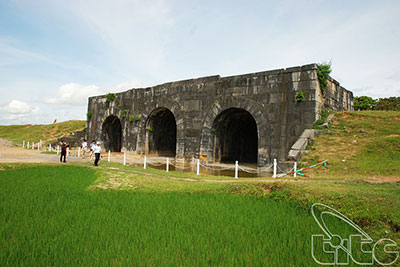The Citadel of Ho Dynasty has been attracting more and more tourists since it was recognized as World Cultural Heritage site in 2011.Vuong Van Viet, Deputy Chairman of Thanh Hoa provincial People’s Committee, expressed his hope that the relic site would boost provincial tourism development in the time to come, according to the Communist Party of Viet Nam Online Newspaper.

The Citadel of Ho Dynasty is the remains of a late 14 th century castle constructed from stone blocks. Citadel of Ho Dynasty, also called Tay Do castle, is rectangular in shape. Its north-south side is 870.5m in length and its east-west side is 88.5m in length. The castle was constructed from stone blocks, each of which is 2x1x0.7m size on average. Except for its gates, the castle is mostly ruined.
Each year, the relic welcomes about 70,000 visitors.
“The Ho Citadel has existed for over seven centuries and experienced the rise and fall of Vietnamese history. It has gigantic stone architecture and the current relic is a small section of the original", said Do Quang Trong, Director of the Conservation Centre for the Ho Citadel.
Over the past two years, the Ho Citadel has gradually revealed more valuable historical items. Notably, the basic but quite comprehensive architecture of Nam Giao Esplanade has been unearthed in an area of over one thousand square metres. The researchers claimed the esplanade is presently the most intact in Vietnam with a series of vestiges such as the Than Dao Road and the King’s well, drainage system. Based on the unearthed vestiges, Thanh Hoa province has reconstructed the large-scale Nam Giao esplanade.
Archaeologists have unearthed the Hoang Gia (Royal) road (also known as Hoe Nhai road) at the southern gate of the citadel with a unique structure. So far, Hoang Gia road has existed intact with a length of about 2km. In addition, the discovery and research of ancient stone exploitation work in An Ton Mountain in Vinh Yen commune and Xuan Dai Mountain in Vinh Ninh commune have special importance in clarifying doubts of the origin of the materials exploited and used to build the Ho citadel.
To attract tourists, local authority has offered folk art performances near the southern gate of the Ho citadel.
Do Quang Trong, Director of the Conservation Centre for Ho Citadel said that to welcome visitors throughout the year, his centre is encouraging local people to provide services for tourists ranging from transport by buffalo and ox cart, trams, to folk art performances and local cuisine.
In the coming time, Thanh Hoa province will focus on building some key tours such as Sam Son - Ho Citadel; Cam Luong Fish Stream – Ho Citadel, according to Vice chairman Vuong Van Viet.
The National Tourism Year 2015 which will be held in Thanh Hoa province will also offer a great opportunity for the castle to welcome more tourists .